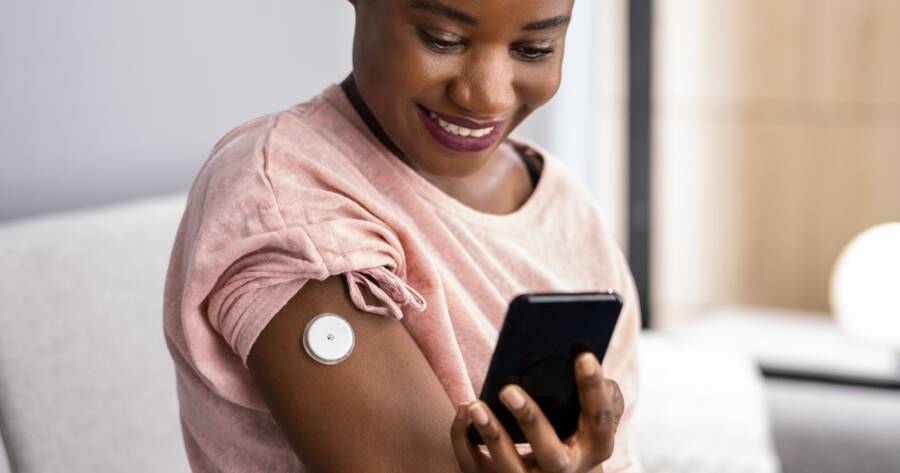Diabetes management has come a long way from the days of manual blood glucose testing and rigid insulin schedules. Today, technology is revolutionizing how individuals manage their condition, offering greater control, convenience, and peace of mind.
What Are Continuous Glucose Monitors?
Continuous glucose monitors (CGMs) are state-of-the-art medical devices that revolutionize the way individuals with diabetes manage their condition. These innovative devices provide real-time, continuous monitoring of glucose levels in the interstitial fluid, offering a wealth of benefits that enhance diabetes management and improve overall well-being.1
CGMs consist of a small sensor that is inserted just beneath the skin, usually on the abdomen or upper arm. This sensor measures glucose levels in the interstitial fluid, which closely correlates with blood glucose levels. The sensor transmits the glucose data wirelessly to a receiver or a smartphone app, allowing individuals to monitor their glucose levels conveniently and discreetly throughout the day and night.
The continuous nature of CGM data provides a comprehensive picture of glucose trends and fluctuations, empowering individuals to make informed decisions about their diabetes management. By identifying patterns, detecting hypoglycemia or hyperglycemia early, and adjusting insulin doses accordingly, CGMs play a pivotal role in achieving optimal glycemic control and preventing complications associated with diabetes.
Real-Time Glucose Levels at Your Fingertips
One of the most significant advantages of CGMs is the ability to provide real-time glucose readings without the need for finger pricks. This feature eliminates the discomfort and inconvenience associated with traditional blood glucose monitoring methods. The continuous stream of glucose data allows individuals to stay informed about their glucose levels at all times, enabling prompt action to maintain glucose within the target range.
The real-time nature of CGM data is particularly beneficial for individuals with type 1 diabetes, who require frequent insulin adjustments to manage their blood sugar levels effectively. By providing immediate feedback on the impact of food, exercise, and insulin doses on glucose levels, CGMs empower individuals to make timely adjustments to their diabetes management regimen, resulting in improved glycemic control and reduced risk of complications.2
Furthermore, the ability to share CGM data with healthcare providers remotely enhances collaboration and facilitates personalized diabetes management. Real-time glucose monitoring empowers individuals to take an active role in their diabetes care, leading to improved outcomes and a better quality of life.
Freedom from Manual Monitoring
CGMs offer unparalleled freedom from the burden of manual blood glucose monitoring. Unlike traditional methods that require multiple finger pricks throughout the day, CGMs provide continuous glucose data without the need for constant monitoring. This liberation from the constraints of frequent testing allows individuals to engage in their daily activities without the constant interruption of blood glucose checks.
The convenience of CGMs is particularly advantageous for individuals with busy lifestyles, those who engage in physical activities, or those who experience difficulty with traditional blood glucose monitoring methods. By eliminating the need for finger pricks, CGMs reduce the risk of infection and discomfort associated with frequent testing, enhancing the overall experience of diabetes management.
Moreover, the discreet nature of CGMs allows individuals to monitor their glucose levels discreetly, without drawing attention to their condition. This feature is particularly beneficial for individuals who may feel self-conscious about their diabetes or who wish to maintain privacy regarding their health condition.
Learn More About Continuous Glucose Monitors
Continuous glucose monitors (CGMs) represent a groundbreaking advancement in diabetes management, offering real-time glucose monitoring, freedom from manual testing, and improved glycemic control. These innovative devices empower individuals with diabetes to take charge of their condition, make informed decisions, and achieve optimal health outcomes.
